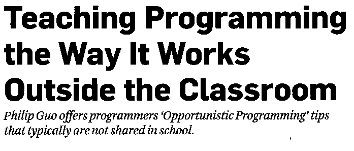
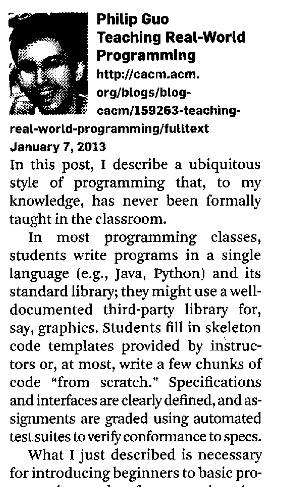
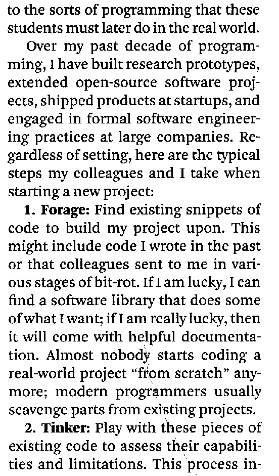
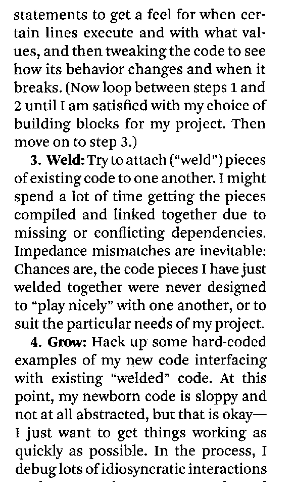
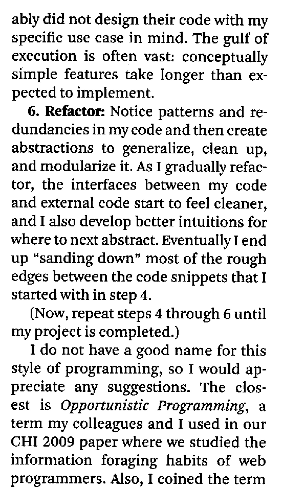
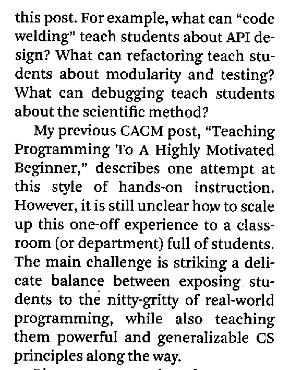 I know "Forage" as "reuse" and this became part of the
formal development process at least 25 years ago.
I know "tinker" as test any software you are about to reuse.
I know "Weld" as integrate existing software into
a your new application.
I know "Forage" as "reuse" and this became part of the
formal development process at least 25 years ago.
I know "tinker" as test any software you are about to reuse.
I know "Weld" as integrate existing software into
a your new application.
[CMSC 345] | [Syllabus] | [Lecture Notes] | [Homework] | [Project] | [Notes, all]
"Those who do not study history are bound to repeat it." "What people learn from history, is that people do not learn from history" Read en.wikipedia.org/wiki/History_of_programming_languages If you are interested in the history of your favorite programming language or some other programming language: Optional Reading: en.wikipedia.org/wiki/C_(programming_language) en.wikipedia.org/wiki/Fortran Some general, not so great, "History of Programming Languages" Many other "history" links. en.wiki/History_of_programming_languages
Another reading assignment. A few questions on mid term exam, just basic concepts.




I know "Forage" as "reuse" and this became part of the formal development process at least 25 years ago. I know "tinker" as test any software you are about to reuse. I know "Weld" as integrate existing software into a your new application.
Based on Lecture 9, Spiral, Rational Unified, and Agile Models: Make four lists: 1) List items that are in all three: Spiral, RUP, and Agile Models 2) List items that appear only in the Spiral Model 3) List items that appear only in the Rational Unified Model 4) List items that only appear in the Agile Model use key words, keep each item to one short line
For the SDD your team needs to express your design in writing.
Not literally just words, there are typically diagrams and
figures.
This homework is to just define the data structure for a
node in a balanced binary tree. Each node has a display name,
a value, optional internal use data, and links to two nodes
below.
+--------+
| Root |
| value1 |
+--------+
/ \
/ \
/ \
+--------+ +---------+
| NodeA | | Node7 |
| valuea | | valuex |
+--------+ +---------+
/ \
/ \
+-------+ +--------+
| Noder | | Nodeq |
| value | | value |
+-------+ +--------+
Use whatever technique or techniques you chose to define the
data structure. You may want to specifically define when
is in each node when it is created. You may want to
specifically define what is in the Root node if it is
different from other nodes.
Then, in some language of your choice, write legal code
that implements your design and the statement that
creates the Root node. Not a complete program, just the
data definition and one or more statements that are
then needed to create the Root node.
There are many visual structures that may be used on a User Interface. For each structure listed below give one example of what a reasonably good use would be. 1) Menu with drop down menu items 2) check boxes 3) radio buttons 4) choice lists 5) single item text entry 6) Multiple line text entry
There are many types and levels of testing. For each Test listed below, give a short explanation of: a) what is being tested b) how the test might be created c) how the test might be performed (manual, automatic, script, ...) d) how the test might be evaluated (quality, completeness, stress, ...) 1) Unit Test 2) Integration Test 3) System Test 4) Acceptance Test
Last updated 10/22/2013